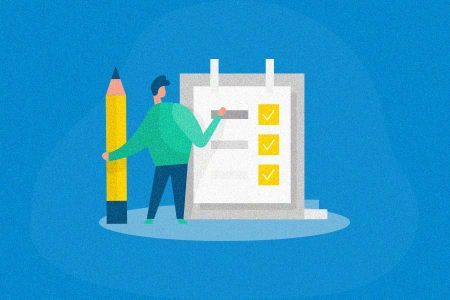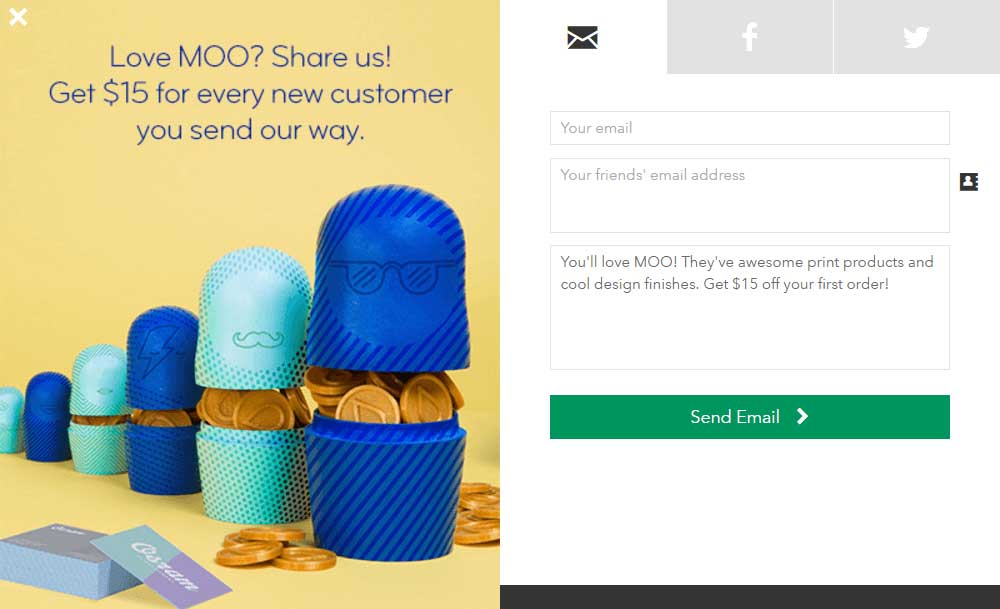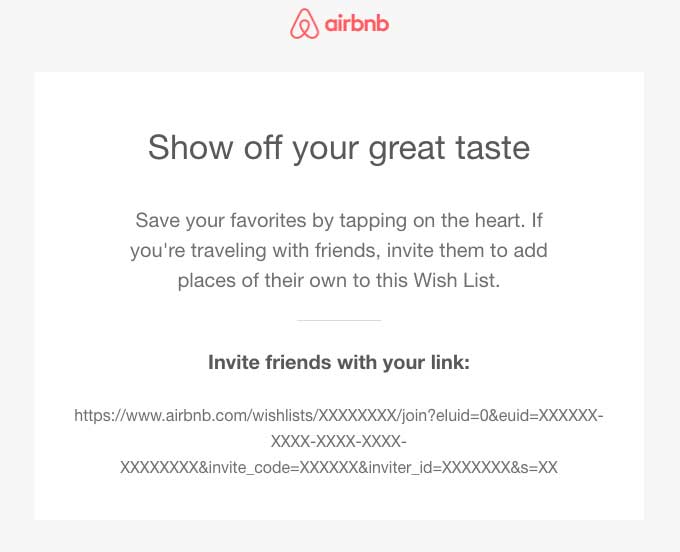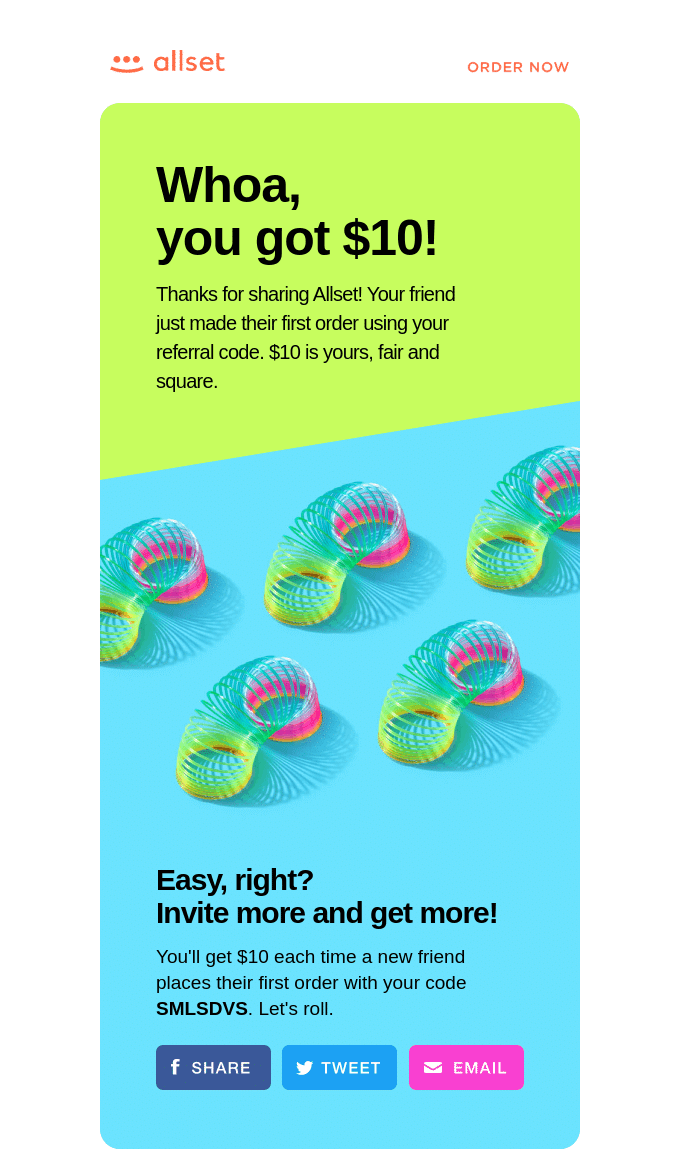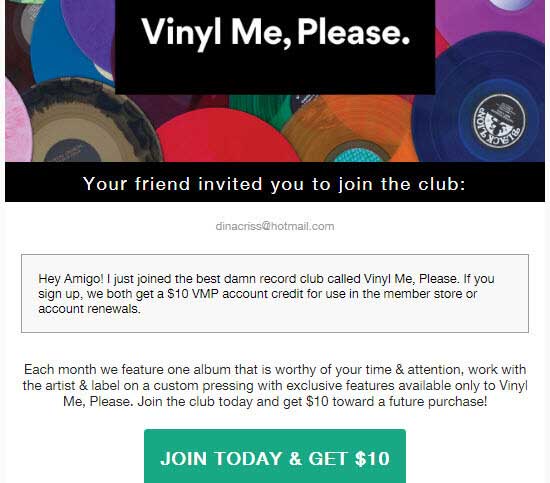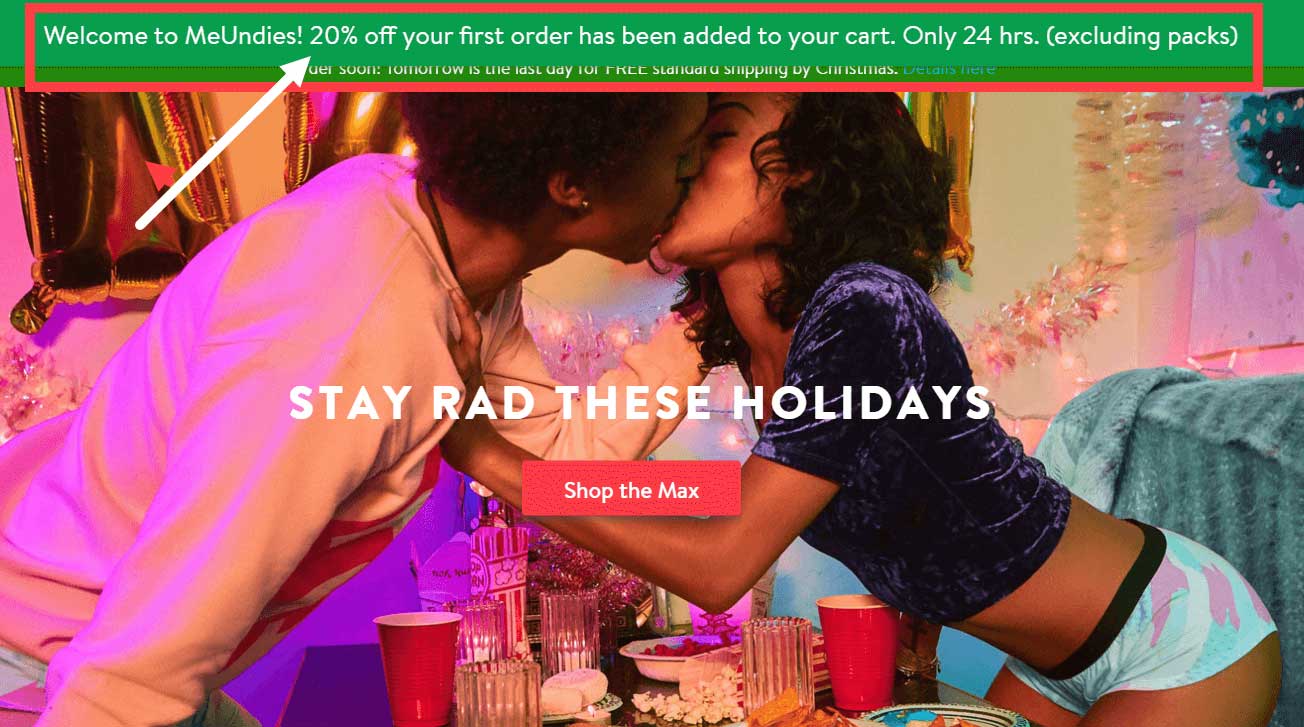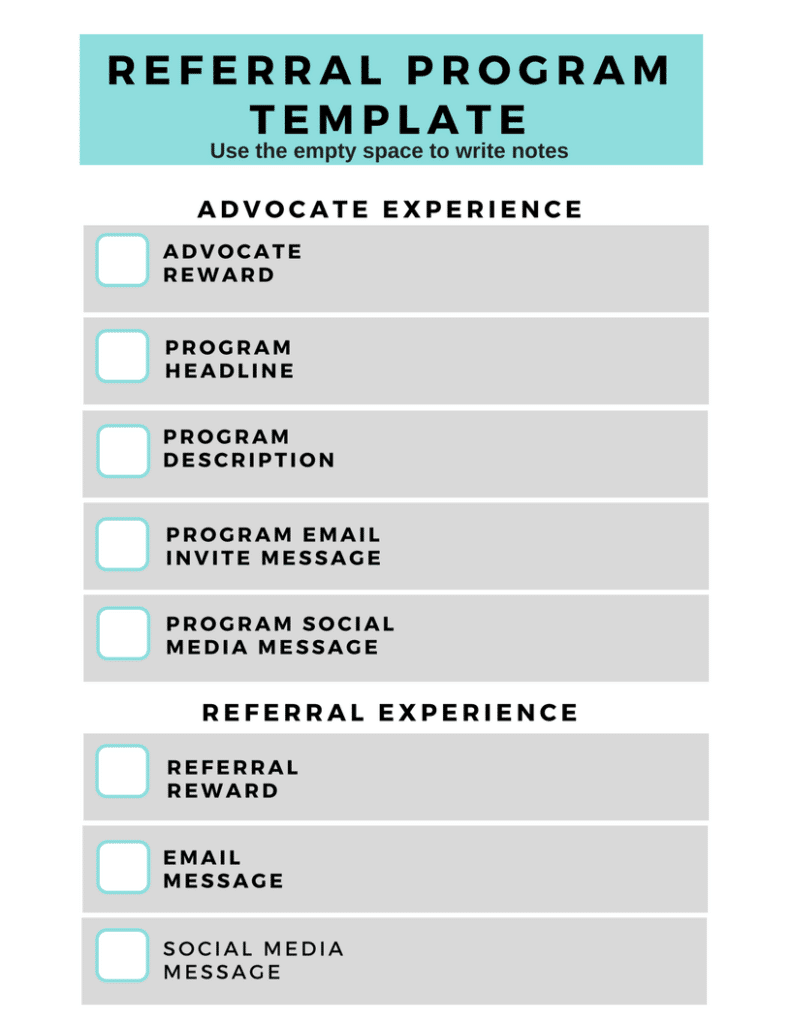Every referral program has the same essential parts, but not all of them are seen by the same people. There are two types of people who participate in a referral program – advocates and referrals – and each sees different parts of your program. Today, we’ll define these two participants in the referral program in more detail, and highlight what they see within the referral program framework.
The advocate
The advocate is your existing customer (also known as a member, brand fan, ambassador, or referrer). They are the one you invite to join your referral program, and help share your company to their friends and family. By signing up for your program, they are agreeing to advocate and promote your brand. 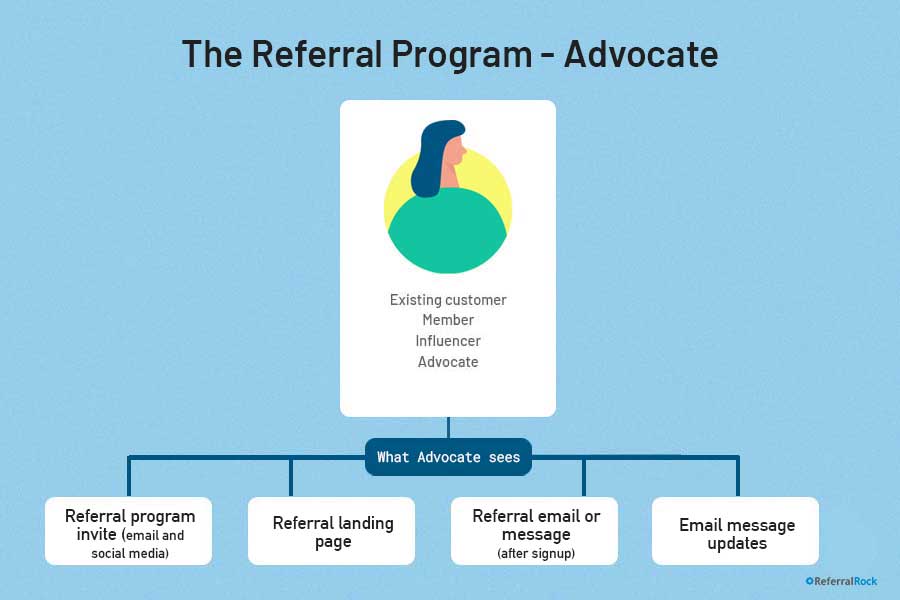
- Referral program invite (email and social media message): Potential advocates are sent a referral program invite. This is usually an email template or social media message that introduces them to the program. It includes the headline, the rewards they can earn, and a CTA that takes them to more information.
- Referral landing page: This is where advocates will land after clicking the link in the program invite. The referral landing page reiterates the program offer, and explains all other details. Also included are a referral program FAQ and sign-up form to join the referral program.
- Referral email or message (after signup): Once an advocate joins your program, it’s time for them to start referring others. Give them a referral link immediately, either through email, text message, or through a dedicated program account portal.
- Email message updates: Keep your advocates engaged with emails about their referrals, reward status, and any other program updates or reminders.
The referral
Referrals are the individuals being referred to your business by the advocate. They have a personal relationship and trust your advocate. By clicking the referral link, they learn more about your brand, and hopefully become a lead or new customer. 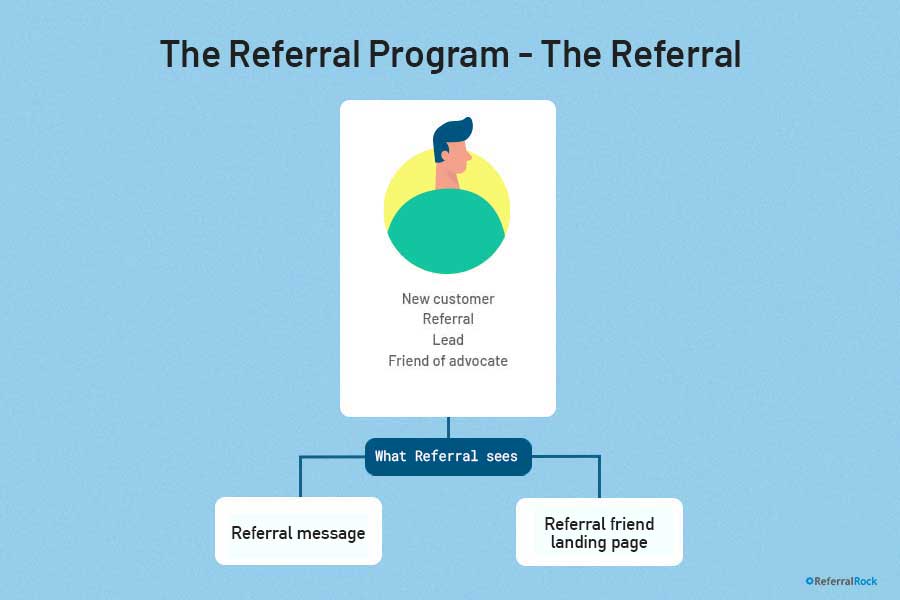
- Referral message: This is the message referrals receive from advocates. It should include a short personalized note about your brand, what makes it so great, and any incentive for making a purchase. The message should also include a referral link that leads to more information, and ties the referral to the advocate.
- Referral landing page (friend landing page): When a referral clicks on a link, they’re sent to a page that may not look very different from the company’s usual pages. Except since they arrived at the page through a referral link, the discount, cashback, or other reward will be applied to their purchase. This is usually indicated by a small note or banner on the page.
Before you use the referral program framework
Before you design the parts of your referral program framework, there are a few elements you need to have ready:
The rewards
What incentives do you plan to offer? People want to know what’s in it for them.
- Have rewards ready for both the advocate and the referral. These double-sided rewards motivate both the advocate to make referrals, and motivate the referral to purchase from you.
- You’ll mention the rewards in nearly every part of your referral program framework.
- On the advocate’s side, you’ll talk about the rewards on offer for both the advocate and their friend.
The referral slogan
This catchy headline encourages sharing and advertises the program’s rewards. You’ll place this on your referral program page, as well as in emails and social media posts promoting your referral program. (Learn more about writing referral slogans.)
The CTAs
The referral call to action, or CTA, shares what you want an advocate or referral to do in 1-3 words. “Share,” “Get $10,” or “Sign up” are great examples. You’ll have different CTAs on the advocate side and referral side, but they’re vital on both sides. Referral CTAs are usually placed on an easy-to-find button, made to stand out from the rest of the page. They encourage action and bring someone to the next step of your referral process.
The referral link
Referral links are essential to your referral program. Advocates receive these unique, trackable links to share with friends. These links track when referred friends click on them and make purchases. Whenever a referral results in a purchase (or other desired action), the link connects the referral back to the exact advocate who sent them, and automatically triggers the rewards for the advocate and friend.
If you’ve got referral software, it will automatically generate referral links for every advocate, and make the links easily accessible for advocates to share.
Referral program framework: What the advocate sees
Now, without further ado, let’s get into the referral program framework. We’ll start by looking at all the parts that the advocate sees.
1. Referral program invite
This is the first step of your referral program – and one of the most important. You’re basically asking existing customers to recommend friends and family through your referral program.
There are a few ways you can invite customers to sign up. We cover the two most popular, email and social media messaging, below:
Referral program email invite
Referral email invites are a great way to contact customers directly. Plus, with all the available email marketing tools, you can easily customize and automate every message you send out. Here are some points a referral email invitation should cover:
Why you’re contacting them
A customer should be able to determine why you’re contacting them at a glance. If a customer isn’t clear about your email, they won’t pay attention or send it straight to trash. Don’t leave that to chance! Instead, give them a reason to open and read your referral email.
- Use the referral program headline as the email subject. Imagine seeing a “Give $50, Get $50” in your inbox. You’ll want to know what you need to do to get $50.
- Use the subject line to draw attention to the exclusive invite. “We think you’re awesome, you’re invited to join!” This gives customers the feeling of being part of an exclusive club – how can you turn that down?
What they get from your refer-a-friend program
Customers want to know what’s in it for them. Even if your subject line tells them what they can earn, it’s always good to reiterate. Start with a short subject line like “Get $25 for helping us,” and then describe the benefits in more detail later on.
How the program works
How can customers sign up for the program and earn these benefits? Explain what they need to do to sign up for the referral program using concise, step-by-step instructions.
A clear call to action
As we covered above, the CTA guides customers to the next step they should take after receiving the invitation, and lets them know what comes next in the referral process.
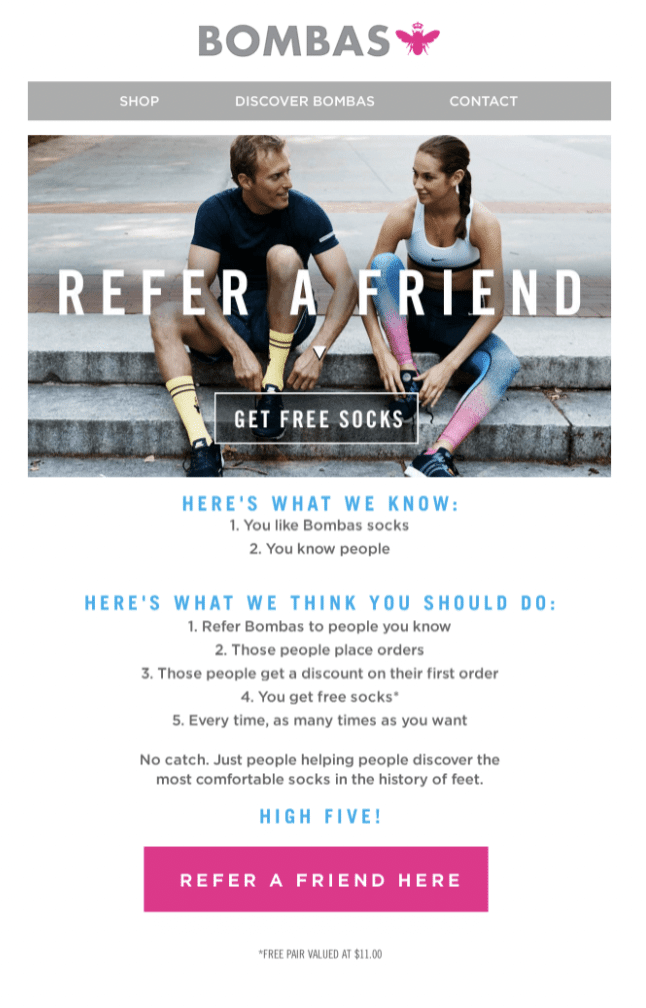
Bombas’ referral program email breaks things down into steps and shows that the referral program is easy for both the advocate and referred friend to use. It tells what you get (free socks!) and how to get it (share with friends who place orders). Plus, it includes smart images of friends enjoying Bombas to support their message. We also love the two call to action buttons: the “get free socks” one above the fold, and the eye-catching pink one at the bottom that reads “refer a friend here.”
Indirect email invites
You can also use your existing drip email newsletters and other messages to promote your referral program.
For instance, if you’re sending out info about a sale or a scheduled newsletter, you can include a CTA for the referral program. This is a smart way to plug your rewards program more subtly and keep it top-of-mind. Simply add a line or two about sharing, what customers can earn, and where to go in order to do so. End with a link or CTA button to a referral program landing page where they can learn more details.
Check out how Casper plugs their referral program at the bottom of an email focused on reviews: “Give $50, Get $50. Refer friends and get rewards.” 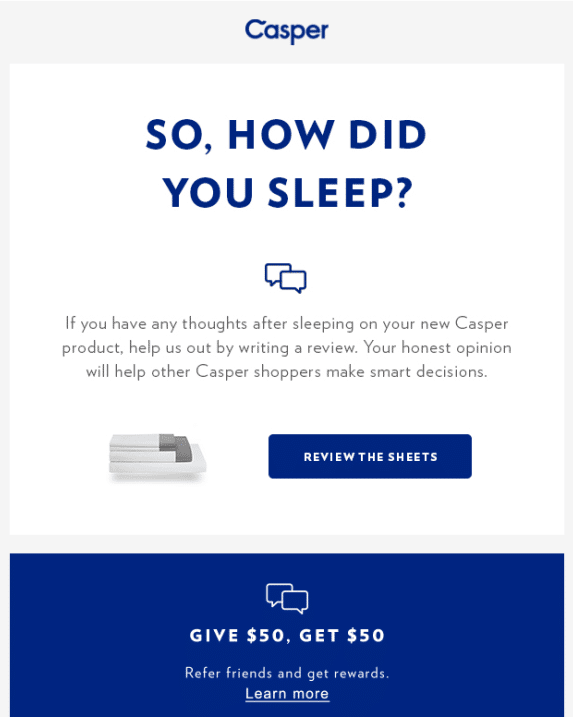
Referral program social media invite
Social media is the perfect platform to invite customers to join your referral program, as it’s where they learn about exciting things and eventually share them with friends.
Most of the time, businesses use the following framework for their social media invites:
- An attractive focal image
- A list of benefits or reasons someone should join
- A link or CTA button to a landing page or sign-up page
Here are some best practices we recommend for a social media invite:
- Maximize your headline: The first thing your followers will see is the headline. Use it to clearly explain what they can expect, what they’ll earn, and why your referral program is so great.
- Explain the program: Tell customers how your program works in a way that’s simple and effective. You don’t want them to search for the logistics, so spell it out in a way that makes sense, reads quickly, and focuses on their reward.
- Highlight the benefits: If you’re giving an incentive to make referrals, make sure to include it in your promotions. Customers who are aware of the benefits upfront are usually more willing to participate.
- Keep your posts fresh: This can mean changing the headline or referral bonus of your program every once in a while to reflect different holidays or seasons. you can also run limited-time programs or promotions, so people will be more motivated to join.
- Include a visual: Visuals are always more eye-catching. Even your logo or a product photo can be enough to draw customers in. Visuals, especially GIFs or short video clips, are great for breaking up chunks of text and encouraging people to read the entire message.
- Directly link to your referral page/pop-up: Make it easy on your users and link them directly to the page. This eliminates any guesswork of where the user is supposed to land, and it increases sign up rates for the referral program.
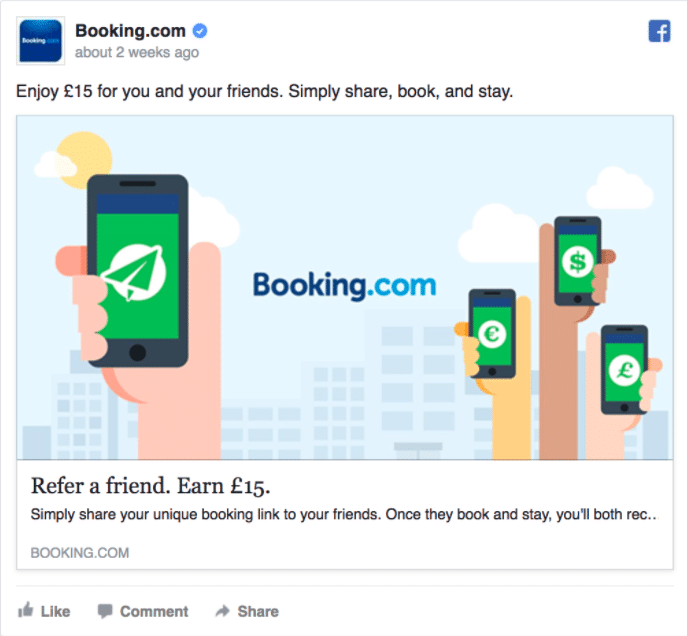
2. Referral program landing page
A referral landing page is the hub of your program, where customers sign up for your program and start sharing. Landing pages give you the space to explain your referral program in more detail: why customers should join, the rules of the program, and any other important information.
There are a few key things that you should include on your referral program page. They include:
- Eye-catching headline: Grab your audience’s attention right from the get-go. Let them know what they can get, and how they can do it. Easy, exciting, and enticing.
- The motivating incentive: The incentive is what gets your current customers to sign up, and it’s what entices new customers to purchase from your brand. Make sure it’s prominently displayed on your program page.
- Short details about the program: How does the program work? How do customers refer friends? What do they get in return? Each of these questions should be answered clearly and easily on the page.
- Compelling imagery: A few strong images can grab the customer’s attention, help explain more about the program, and break up any large blocks of text.
- Terms and conditions: What must be done in order to earn the incentive? Is there a limit to referral rewards? Lay out the facts so customers know what to expect and how to earn their reward.
- Multiple options to refer friends: Allow your customers to reach friends in several ways, including email, social media, and a referral link. The more options you present for referring friends, the more referrals you’ll receive.
- A referral CTA: This is the whole point of the page, as it sums up action you want the customer to take. Some common CTAs are “Sign up,” “Join now,” or “Start sharing,” but don’t be afraid to get creative. Just make sure it matches the action you want customers to take (referring).
Don’t forget to optimize this page for mobile!
MOO invites customers to join its referral program using an attractive widget. The widget does a good job of explaining the referral program benefit right in the headline, and gives customers more information at the click of a button. Customers can share MOO in multiple ways: email, social media, and directly through a referral link.
3. Referral email or message (after signup)
Send advocates their referral link as soon as they sign up to the program. They’re ready to refer and you don’t want to keep them from sharing you with others. You can assign the referral link (or referral code) while they’re still on your website, or within customer referral portal. You should also send them an email, so the link is even easier to access.
4. Email message updates
The key to a scalable referral program is keeping up promotions, even after advocates have signed up. Just like any marketing campaign, it’s important to keep people engaged and excited to generate word of mouth. Send your advocates timely emails or messages updating them with how many referrals they’ve sent, new rewards they can earn, limited-time contests, and any other news about your referral program. And when a referral makes a purchase, update the advocate right away and use this opportunity to motivate even more sharing.
Referral program framework: What the referral sees
Now that we’ve gone over the parts of the framework that apply to the advocate, let’s cover the parts that the referred friend sees.
1. Referral message
The first message sent to referrals plays an important part in your program framework. After all, it may be one of the first things someone reads about your business. To help advocates share quicker, it’s good to provide a pre-filled referral message template they can customize on their own. The great part about a referral invitation message is that it comes from a personal contact.
- The message is more casual.
- It’s more personal and trusted.
- It doesn’t have to be sales-y.
- People are more inclined to click and read through.
Most referral software enables you to create a pre-filled email message for advocates to send to their friends.
We’ve rounded up a few tips to get your referral message on the right track. Again, we focus on the two most popular referral channels – email and social media. But these tips can be used to create referral messages across every channel.
- Use a fun intro or subject line: Start your referral message with a fun or interesting note. It also helps if you can include the referral’s first name in the subject line. This personal touch will help the message stand out in a referral’s inbox or feed, and increase chances your message will be read.
- Let them know who sent the message: Whenever someone gets a message, the first thing they look at is who sent it. In this case, it’s best to let them know the message comes from a friend. Even if the referral message is about a business or product, people always trust their friends and family over other sources.
- Introduce your company (briefly): Sometimes a referral may not have heard of your company. This is your chance to introduce yourselves and show them why you’re so great. It’s best not to go overboard, though – sharing your products and what you do is more than enough.
- Highlight the benefits: You’ve explained the benefit to your existing customers. Now, it’s time to do the same for potential new customers. If your referral also gets an incentive, mention it early in the message. This incentivizes referrals to join your program and try your products.
- Add a CTA: Ending a referral message with a CTA makes it easy for anyone to take the next steps and join your program. Place a link or a button that stands out from the rest of your referral message, showing referrals exactly how they can take the next step in the referral process.
Vinyl Me, Please sends a fun email message to referrals. The email covers who they are, what they do, and goes over the details of the referral program, from the peer’s point of view. “Hey, Amigo! I just joined the best damn record club called Vinyl Me, Please. If you sign up, we both get a $10 VMP account credit for use in the member store or account renewals.”
2. Friend landing page
The friend landing page, or referral landing page, is where all referrals end up after they click on a referral link. While this page is usually similar to the pages everyone else sees, there’s one important difference. The referral process is being tracked thanks to the code in the referral link, and the reward will be applied if they purchase. Oftentimes, this reward is advertised through a small banner or pop-up message.
The landing page referrals see will depend on your type of business, and the next step you want referrals to take.
MeUndies has a great example of a friend landing page experience. When a referral clicks on the link in the referral message, they are brought to the MeUndies homepage, and the referral coupon code is automatically added to their shopping cart. The referral is also tied back to the advocate who referred them.
Follow the referral program framework
Now that you know about the key elements of a referral program framework, and have seen a lot of great examples, it’s time to create your own. Here’s a checklist you can use:
Now, it’s time to build a program of your own.
Referral software makes it easy to design a program that follows this proven framework. Quickly set up all the necessary pages and promotions for your program, create referral links, and instantly issue rewards once they’re earned.
